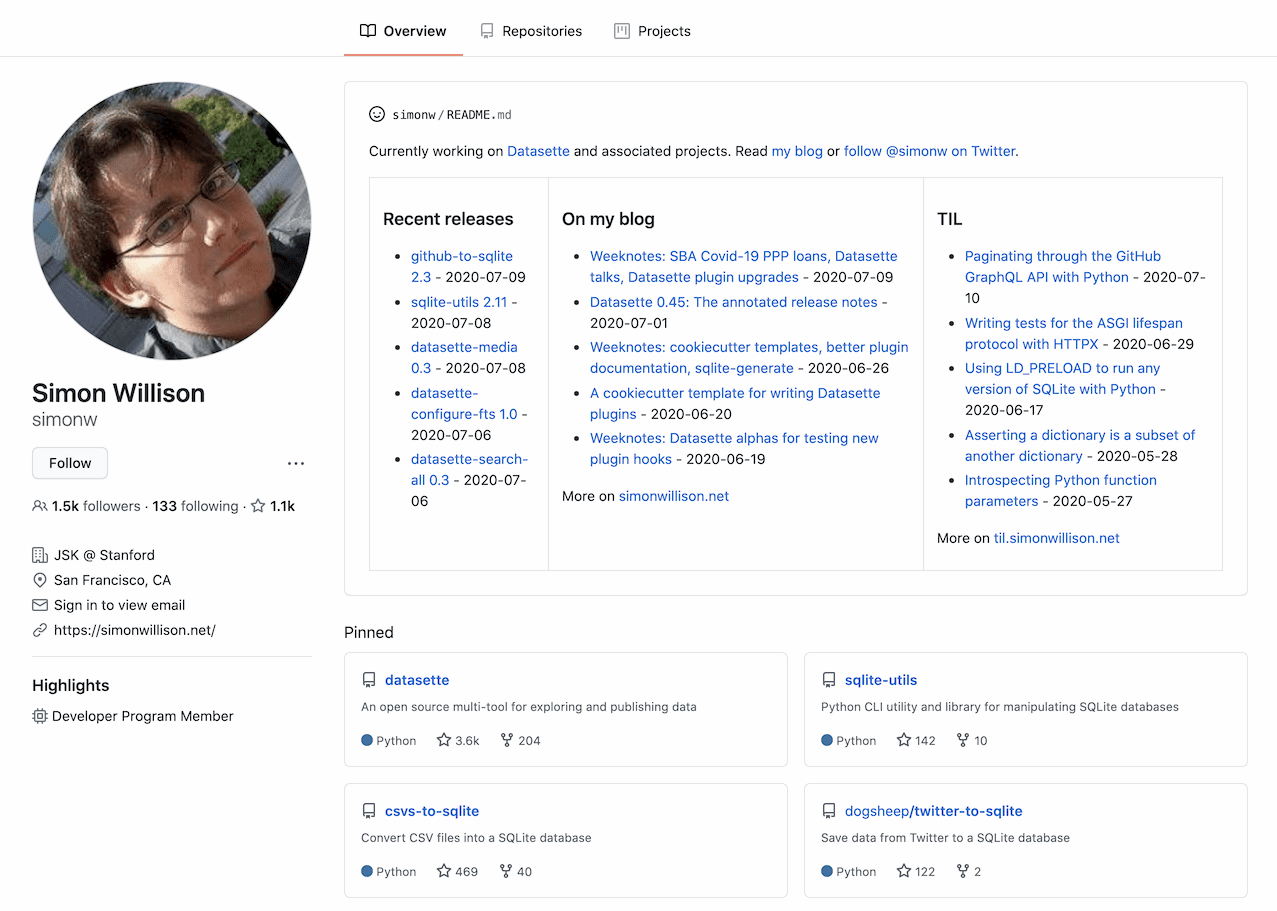Building a self-updating profile README for GitHub
GitHub quietly released a new feature at some point in the past few days: profile READMEs. Create a repository with the same name as your GitHub account (in my case that’s github.com/simonw/simonw), add a README.md to it and GitHub will render the contents at the top of your personal profile page—for me that’s github.com/simonw
I couldn’t resist re-using the trick from this blog post and implementing a GitHub Action to automatically keep my profile README up-to-date.
Visit github.com/simonw and you’ll see a three-column README showing my latest GitHub project releases, my latest blog entries and my latest TILs.

I’m doing this with a GitHub Action in build.yml. It’s configured to run on every push to the repo, on a schedule at 32 minutes past the hour and on the new workflow_dispatch event which means I get a manual button I can click to trigger it on demand.
The Action runs a Python script called build_readme.py which does the following:
- Hits the GitHub GraphQL API to retrieve the latest release for every one of my 300+ repositories
- Hits my blog’s full entries Atom feed to retrieve the most recent posts (using the feedparser Python library)
- Hits my TILs website’s Datasette API running this SQL query to return the latest TIL links
It then turns the results from those various sources into a markdown list of links and replaces commented blocks in the README that look like this:
<!-- recent_releases starts -->
...
<!-- recent_releases ends -->The whole script is less than 150 lines of Python.
GitHub GraphQL
I have a bunch of experience working with GitHub’s regular REST APIs, but for this project I decided to go with their newer GraphQL API.
I wanted to show the most recent “releases” for all of my projects. I have over 300 GitHub repositories now, and only a portion of them use the releases feature.
Using REST, I would have to make over 300 API calls to figure out which ones have releases.
With GraphQL, I can do this instead:
query {
viewer {
repositories(first: 100, privacy: PUBLIC) {
pageInfo {
hasNextPage
endCursor
}
nodes {
name
releases(last:1) {
totalCount
nodes {
name
publishedAt
url
}
}
}
}
}
}This query returns the most recent release (last:1) for each of the first 100 of my public repositories.
You can paste it into the GitHub GraphQL explorer to run it against your own profile.
There’s just one catch: pagination. I have more than 100 repos but their GraphQL can only return 100 nodes at a time.
To paginate, you need to request the endCursor and then pass that as the after: parameter for the next request. I wrote up how to do this in this TIL.
Next steps
I’m pretty happy with this as a first attempt at automating my profile. There’s something extremely satsifying about having a GitHub profile that self-updates itself using GitHub Actions—it feels appropriate.
There’s so much more stuff I could add to this: my tweets, my sidebar blog links, maybe even download statistics from PyPI. I’ll see what takes my fancy in the future.
I’m not sure if there’s a size limit on the README that is displayed on the profile page, so deciding how much information is appropriate is appears to be mainly a case of personal taste.
Building these automated profile pages is pretty easy, so I’m looking forward to seeing what kind of things other nerds come up with!
from Hacker News https://ift.tt/3iQKHHt
No comments:
Post a Comment
Note: Only a member of this blog may post a comment.